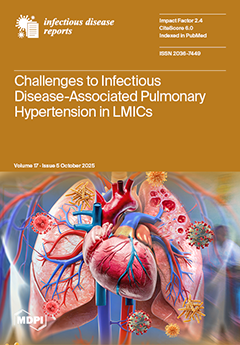Backgrunod/Objectives: Routine identification of common bacterial pathogens is typically efficient, utilizing standardized, cost-effective methods. However, the diagnostic process becomes significantly more complex when dealing with rare or unexpected microorganisms, especially as they can be considered colonizers in many cases.
Methods: This study presents diagnostic details of an uncommon pathogen,
Vibrio alginolyticus, isolated from auricular discharge in a patient with non-Hodgkin lymphoma diagnosed with persistent otitis externa and explores its identification through both conventional and modern laboratory approaches. Sequential ear discharge cultures resulted in phenotypically similar but genomically different
Vibrio alginolyticus isolates. We complemented classical methods like conventional culture (on Columbia agar and CLED agar), Vitek2 Compact identification, and EUCAST disk diffusion antimicrobial susceptibility testing (following the EUCAST version 12.0 guidelines) with MALDI-TOF mass spectrometry and Illumina/Nanopore whole genome sequencing. Comparative analysis of the genomes was performed with the PeGAS pipeline, Unicycler, and 1928Diagnostics SNP analysis.
Results: The Vitek2 analysis identified both isolates as
V. alginolyticus with 99% confidence, and this was supported by the MALDI-TOF MS results. The first isolate (A) was fully susceptible to the antibiotics tested, while the second (B) showed resistance to ciprofloxacin. Whole genome sequencing revealed 99.23% and 98.60% nucleotide identity to the
V. alginolyticus reference genome for isolates A and B, respectively, with a 99.8% match between them. Isolate B acquired a
gyrA (c.1870C>T) mutation that correlates with the ciprofloxacin resistance (MIC > 0.5 mg/L). Both genomes carry
hlyA (hemolysin),
toxR (cholera toxin regulator), genes involved in biofilm formation (
rpoN,
relA,
spoT,
opp),
luxS (motility),
proA,
vacB (virulence factors), and
tet(34) (oxytetracycline resistance). A core genome SNP distance of <100 indicates clonal relatedness. Our integrated (phenotypic and genomic) diagnostic approach confirmed
V. alginolyticus and documented host resistance evolution, with a virulence repertoire that could explain the clinical evolution.
Conclusions: This case highlights the utility of molecular methods in confirming species identity, detecting resistance markers, characterizing virulence determinants, and differentiating a pathogen from a colonizer, supporting targeted clinical management.
Full article






